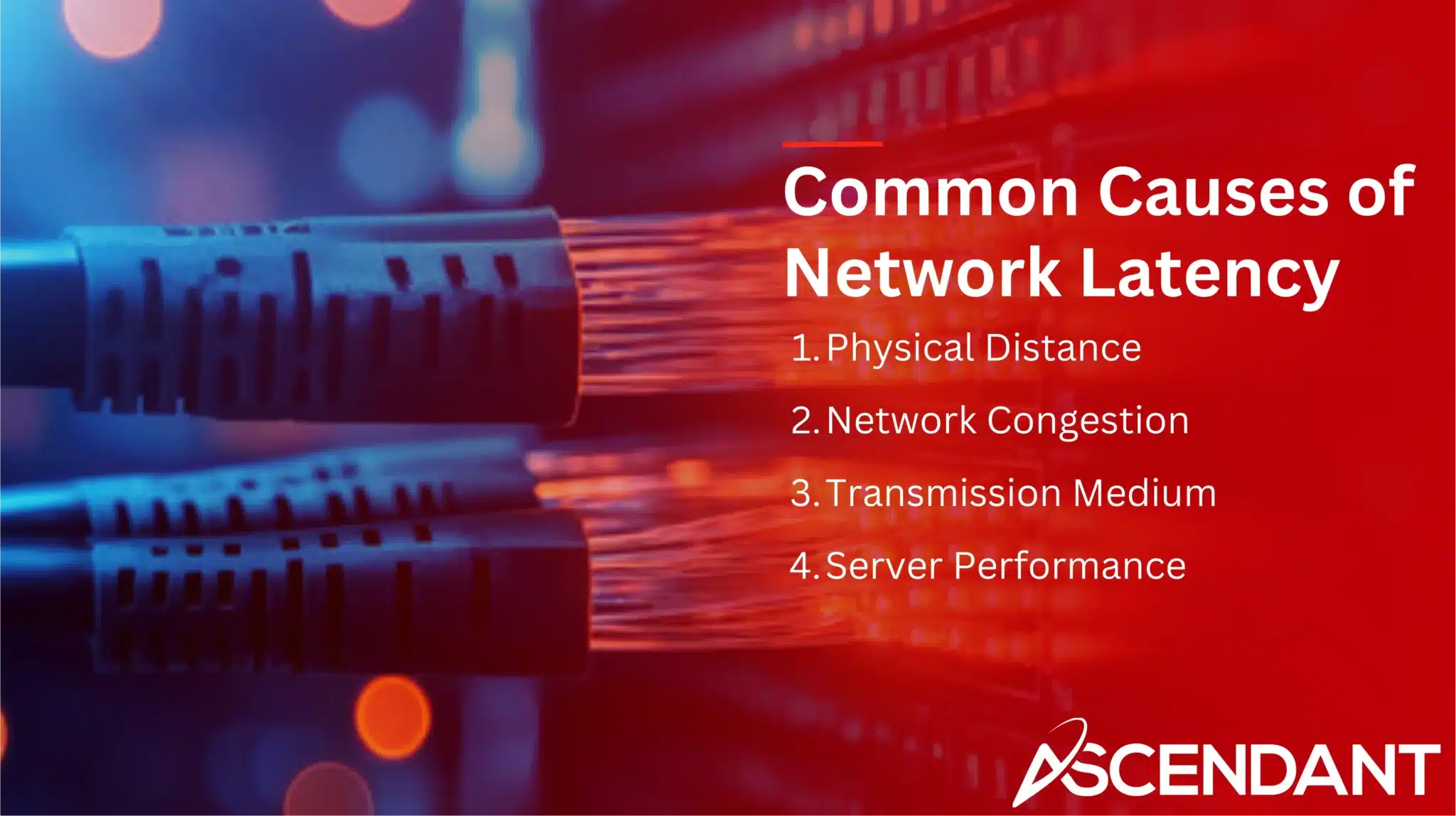Network latency is the delay in data transmission over a network. It affects how fast web pages load, video calls, and online games. This article explains what latency is, its causes, and ways to reduce it.
In This Article:
- Understanding Network Latency
- Common Causes of Network Latency
- Impact of Network Latency on Applications
- Proven Strategies to Reduce Network Latency
- Tools for Measuring and Monitoring Network Latency
- How Businesses Benefit from Low Latency Networks
- Future Trends in Reducing Network Latency
Key Takeaways
- Network latency is a critical factor affecting data transfer speed and application performance, measured by metrics such as Time to First Byte (TTFB) and Round Trip Time (RTT).
- Common causes of network latency include physical distance, network congestion, transmission medium, and server performance, all of which can degrade user experience and application efficiency.
- Implementing strategies like optimizing code, utilizing Content Delivery Networks (CDNs), and upgrading network infrastructure can significantly reduce network latency, benefiting businesses through improved productivity and user experience.
Understanding Network Latency
The duration required for data to journey from its origin to its endpoint within a network is referred to as network latency. This fundamental idea plays an essential role in ensuring effective and seamless functioning of the network, influencing diverse aspects such as web page loading speeds, online gaming fluidity, and the quality of video conferencing.
Understanding latency along with its influence on how well a network functions serves as a preliminary measure in reducing any detrimental consequences it might pose.
Definition and Importance
The time delay from the moment a data transfer instruction is issued until the actual transfer commences is known as latency, and it’s commonly quantified in milliseconds. For applications that require high-performance computing, maintaining low latency is essential. It enhances the overall user experience and guarantees that business operations are carried out efficiently. This reduction in delays enables businesses to operate in real-time, which can significantly boost productivity.
On the other hand, experiencing high latency can result in considerable drawbacks for efficient performance within business operations—particularly those dependent on real-time functionality—which could negatively influence overall effectiveness.
Key Metrics for Measuring Latency
Crucial indicators for gauging network latency include metrics such as Time to First Byte (TTFB) and Round Trip Time (RTT). TTFB evaluates the duration of server processing and network lag, revealing the swiftness of a server’s response upon receiving a request.
In contrast, RTT calculates the period required for a client to dispatch a request and obtain an answer, showcasing total communication delays. The assessment of both TTFB and RTT is essential in determining the caliber of network performance and pinpointing problems related to latency.
Common Causes of Network Latency
Network performance can be adversely affected by several elements, such as the transmission medium employed, server performance quality, network congestion, and the physical distance involved. These aspects are capable of inducing considerable delays and reducing efficiency due to network latency issues.
Physical Distance
Network latency is often due to the physical distance between devices and servers, as data must travel distances resulting in longer transmission delays. For example, when a server located in New York sends data to a user based in Tokyo, there will be an increased travel time because of the substantial physical distance.
By situating servers nearer to where users are located, it’s possible to enhance the user experience considerably by diminishing the network distance that data needs to traverse.
Network Congestion
When numerous users attempt to access data at the same time, congestion occurs, leading to delayed packet delivery. The situation is worsened by high traffic volume, which results in increased queueing latency and dropped packets, thus magnifying the delays. Constrained bandwidth along with sizeable content can contribute to congestion, consequently impairing performance.
Transmission Medium
The type of transmission medium is pivotal in establishing latency, as it greatly influences the speed at which data transmission occurs. For example, fiber optic cables are superior to copper cables in reducing latency because light propagates through a fiber optic cable much quicker—at an estimated 4.9 microseconds per kilometer—making them an optimal selection for those aiming to minimize delay times.
Server Performance
Operational latency from computing operations affects server performance, contributing to network latency. Outdated hardware and poorly designed applications can exacerbate these issues, increasing latency in data processing and retrieval.
Regular maintenance and investment in high-quality hardware can help reduce these delays.
Impact of Network Latency on Applications
Latency that is too high can have a drastic effect on the performance of applications, resulting in inefficiencies and a negative user experience. This issue is especially critical for real-time applications, video conferencing, and cloud-based applications where slight delays can lead to significant problems.
Real-Time Applications
For applications that require immediate data processing, like online gaming and financial trading, latency is of paramount importance. Even slight lags can deteriorate the gaming experience or result in lost opportunities for traders.
Edge computing technology plays a pivotal role in facilitating real-time data processing for these kinds of applications where any delay is unacceptable.
Video Conferencing
Lag, interruptions, and diminished experiences in video conferencing are caused by network latency. For real-time applications such as online meetings, maintaining low latency is essential to avoid delays that can hinder communication.
It is critical to manage latency effectively in order to preserve the quality of video and audio during interactions.
Cloud-Based Applications
Enhanced user experiences in cloud-based applications are driven by the rapid transfer of data, attributed to low latency. This improvement not only streamulates interaction but also heightens productivity as employees can utilize tools with greater efficiency, thus facilitating uninterrupted workflows.
Proven Strategies to Reduce Network Latency
To enhance network performance and user experience, strategies such as code optimization, employing Content Delivery Networks (CDNs), and upgrading the network infrastructure are employed to reduce network latency.
Optimizing Code and Queries
Inefficiently written applications and suboptimal code can greatly affect the performance and overall user experience. By streamlining both code and database queries, you reduce wait times for data access and processing, thus enhancing operational efficiency.
Utilizing Content Delivery Networks (CDNs)
Content Delivery. Networks enhance the user experience by caching content in proximity to users, thereby reducing network latency. By cutting down the physical distance that data has to traverse and easing the burden on source servers, CDNs improve response times significantly.
Upgrading Network Infrastructure
By allocating resources to acquire state-of-the-art hardware, software, and optimized configurations, one can substantially improve the efficiency of network performance. Enhancements to the network infrastructure—including superior hosting services and minimizing the distances data must travel—can lead to decreased latency and bolstered overall system performance.
Tools for Measuring and Monitoring Network Latency
Utilizing tools such as Ping, Traceroute, and sophisticated network monitoring solutions is crucial for assessing network latency. These instruments aid in identifying the origins of latency issues and determining their impact on the overall performance of the network, enabling proactive management.
Ping and Traceroute
The Ping tool tests if a system is online and measures response time. Traceroute identifies the path a data packet takes from source to destination, mapping the traffic route and measuring latency at each hop, including how data packets traverse the network.
These tools are vital for assessing network connection and performance.
Advanced Network Monitoring Tools
Sophisticated instruments such as SolarWinds and Auvik enhance the precision in gauging network latency. They deliver continuous surveillance and issue notifications for disruptions or augmented latency to preserve optimal performance.
How Businesses Can Benefit from Low Latency Networks
A network with low latency enhances the user experience and boosts productivity by enabling faster communication and more efficient operations, thereby greatly improving business performance.
Enhanced User Experience
Enabling real-time interactions and rapid data processing, low latency is crucial for startups and companies. By serving content from the closest server to reduce transit distance, Content Delivery Networks (CDNs) elevate the user experience through enhanced performance.
Increased Productivity
Enhancing productivity in cloud-based applications can be achieved by reducing latency, which diminishes delays and augments performance. To ensure efficiency is maintained and productivity heightened, it’s crucial to routinely examine and refine the code as well as optimize database queries.
Future Trends in Reducing Network Latency
Advancements in connectivity and infrastructure, which are among the emerging technologies, endeavor to enhance network latency. The increasing number of mobile and IoT devices introduces challenges that will influence how network latency reduction is addressed moving forward.
5G Networks
5G technology is designed to substantially decrease the latency users encounter. By improving data transmission speeds and accommodating a larger number of connected devices, 5G strives to diminish the total delay in network interactions.
Edge Computing
Processing data in proximity to source devices, edge computing minimizes the volume of information that needs to be transmitted to the cloud. By doing so, it cuts down on latency and boosts both the velocity and reactivity of applications, thereby elevating real-time user experiences.
Summary
In summary, network latency is an important factor that affects data transmission speed and overall application performance. High latency can lead to slower web browsing, disrupted video calls, and lag in real-time applications, which is why it is vital for businesses to address latency issues preemptively. By understanding its causes—such as physical distance, network congestion, and server performance—organizations can implement strategies like optimizing code, using CDNs, and upgrading network infrastructure. With advancements like 5G and edge computing on the rise, reducing network latency will continue to be a priority for improving user experience and business efficiency.
 Frequently Asked Questions
Frequently Asked Questions
What is network latency?
Understanding network latency, the duration measured in milliseconds that data requires to journey from its origin to its destination across a network, is essential because it affects application performance and responsiveness.
Why is low latency important for businesses?
Ensuring low latency is vital for enterprises because it not only boosts the user experience but also supports real-time activities, which in turn increases productivity and operational effectiveness.
What are the common causes of network latency?
The common causes of network latency are physical distance, network congestion, the type of transmission medium, and server performance.
Understanding these factors can help in diagnosing and improving network efficiency.
How can businesses reduce network latency?
Businesses can effectively reduce network latency by optimizing their code, implementing Content Delivery Networks (CDNs), and upgrading their network infrastructure.
Prioritizing these strategies will enhance overall performance and user experience.
What tools can be used to measure and monitor network latency?
It is recommended to use tools like Ping and Traceroute, along with sophisticated network monitoring systems such as SolarWinds and Auvik, for efficient measurement and oversight of network latency.
Employing these instruments offers crucial information on the functioning of networks.


